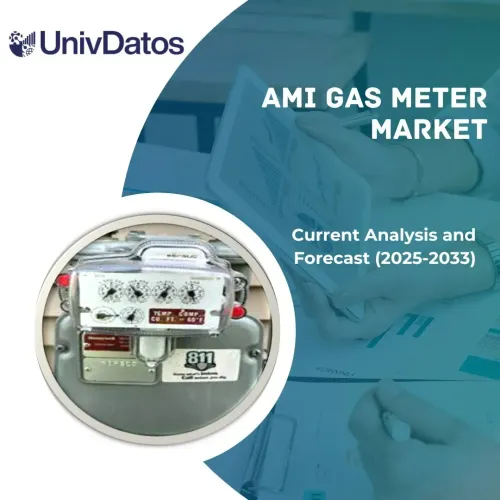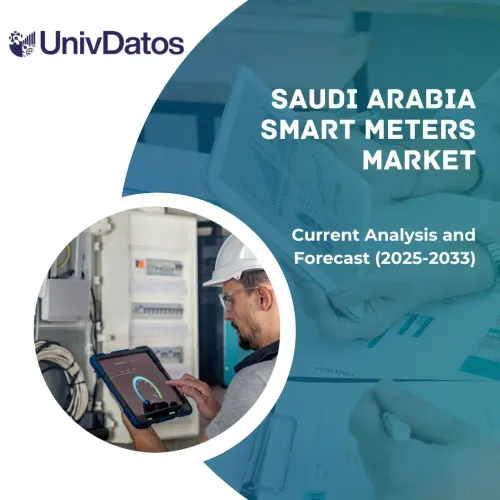- Startseite
- Über uns
- Industrie
- Dienstleistungen
- Lesen
- Kontaktieren Sie uns
Transformatorüberwachungsmarkt: Aktuelle Analyse und Prognose (2024-2032)
Schwerpunkt auf Service (Öl & Gas Überwachung, Durchführung Überwachung und Andere); Lösung (Hardware, Software); Anwendung (Leistungstransformator, Verteilungstransformator und Andere); und Region/Land
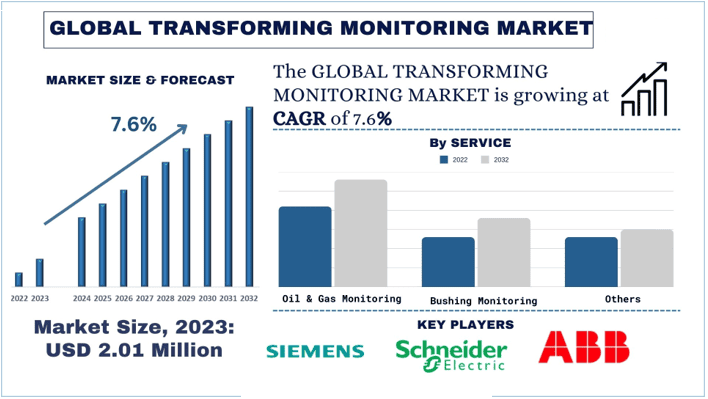
Marktgröße und Prognose für die Transformatorüberwachung
Der Markt für die Transformatorüberwachung wurde im Jahr 2032 auf 3,89 Millionen USD geschätzt und wird im Prognosezeitraum (2024–2032) voraussichtlich mit einer starken CAGR von rund 7,6 % wachsen, was auf die von Ländern auf der ganzen Welt für 2030 festgelegten Netto-Null-Emissionsziele zurückzuführen ist, um den Übergang zu erneuerbaren Energien zu stimulieren.
Marktanalyse für die Transformatorüberwachung
Transformatoren sind eine äußerst wichtige Komponente des Stromnetzes, die in verschiedenen Anwendungen eingesetzt werden, von kleinen Projekten bis hin zu Mega-Industrien, und sogar zur Überwachung von Steuerungs- und Datenerfassungssystemen. Es ist von entscheidender Bedeutung, Transformatoren zu überwachen, um sicherzustellen, dass sie ordnungsgemäß funktionieren. Die Transformatorüberwachung umfasst die aktive Überwachung verschiedener Betriebsmerkmale. Transformatorüberwachungsgeräte sammeln Daten und senden Alarme, um den Benutzer zu benachrichtigen, wenn etwas nicht in Ordnung zu sein scheint. Verschiedene Arten von Transformatorüberwachungsgeräten sind leicht verfügbar, um die Symptome eines Transformatorausfalls zu erkennen, indem sie das Kühlsystem, den Laststufenschalter, gelöstes Gas, den Leistungsfaktor und die Kapazität der Durchführung, Teilentladungen, Ölstände, Druck, Temperaturen und mehr überwachen. Darüber hinaus verstärkt der jüngste technologische Fortschritt in der Infrastruktur für die Transformatorüberwachung die Marktnachfrage weiter. Zum Beispiel: Im Jahr 2024 wurde der UbiGrid™ Transformer Fault Detector (TFD+) ferngesteuert eingeführt, um Transformatorfehler zu erkennen, unnötige Austausche zu vermeiden und die Sicherheit der Besatzung beim Wiedereinschalten zu gewährleisten.
Markttrends für die Transformatorüberwachung
Wachsender technologischer Fortschritt auf dem Markt für die Transformatorüberwachung
Der Markt für die Transformatorüberwachung hat aufgrund des Fortschritts der KI-Technologie ein deutliches Wachstum erlebt. Dies hat die Art und Weise verändert, wie Transformatoren überwacht und gewartet werden. Die Transformatorüberwachung ist entscheidend, um den effizienten und zuverlässigen Betrieb von elektrischen Energiesystemen zu gewährleisten. Traditionelle Überwachungsmethoden umfassten manuelle Inspektionen und regelmäßige Wartungskontrollen, die arbeitsintensiv und anfällig für menschliche Fehler waren. Die KI-Technologie hat die Transformatorüberwachung jedoch ausgefeilter und effizienter gemacht. KI-gestützte Lösungen stützen sich auf Algorithmen für maschinelles Lernen, um große Datenmengen zu analysieren, die von Transformatoren in Echtzeit erfasst werden. Diese Algorithmen können Muster, Anomalien und potenzielle Probleme mit großer Genauigkeit erkennen und so vorausschauende Wartung und proaktive Maßnahmen ermöglichen, bevor es zu einem Ausfall kommt. Einer der Hauptvorteile der KI-Technologie bei der Transformatorüberwachung ist die Möglichkeit, Ausfallzeiten und Wartungskosten zu reduzieren. Durch die Vorhersage potenzieller Ausfälle, bevor sie auftreten, können Betreiber Wartungsaktivitäten effektiver planen und so das Risiko unerwarteter Ausfälle und kostspieliger Reparaturen minimieren.
Darüber hinaus können KI-gestützte Lösungen die Leistung von Transformatoren optimieren, was zu einer Steigerung der Effizienz und Produktivität in Energiesystemen führt. Darüber hinaus machen die Skalierbarkeit und Flexibilität der KI-Technologie sie für eine breite Palette von Anwendungen auf dem Markt für die Transformatorüberwachung geeignet. KI-gestützte Lösungen können in bestehende Überwachungssysteme und Sensoren integriert werden und bieten so einen umfassenden Überblick über den Zustand und die Leistung des Transformators. Diese Vielseitigkeit hat zum raschen Wachstum des Marktes beigetragen, da immer mehr Organisationen den Wert von KI erkennen.
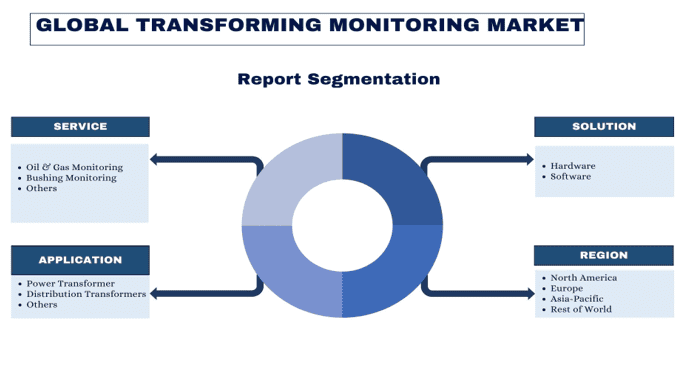
Es wird erwartet, dass der asiatisch-pazifische Raum im Prognosezeitraum mit einer deutlichen CAGR wachsen wird
Die Region Asien-Pazifik hat sich zu einem wichtigen Akteur auf dem Markt für die Transformatorüberwachung entwickelt und ist führend bei der Förderung von Innovationen und der Revolutionierung von Industrien. Die jüngsten Entwicklungen und Regierungsinitiativen in der Region haben die Nachfrage nach Lösungen für die Transformatorüberwachung weiter beschleunigt und den asiatisch-pazifischen Raum als weltweit führend in diesem Sektor positioniert. Einer der Schlüsselfaktoren für diese Transformation sind die rasanten technologischen Fortschritte in Ländern wie China, Japan, Südkorea und Singapur. Diese Länder haben stark in Forschung und Entwicklung investiert, was zur Entwicklung modernster Überwachungstechnologien geführt hat, die Branchen wie das Gesundheitswesen, das verarbeitende Gewerbe, das Transportwesen und die Energieversorgung verändern. Auch Regierungsinitiativen zur Förderung der Digitalisierung und Automatisierung haben eine entscheidende Rolle bei der Ankurbelung der Nachfrage nach Lösungen für die Transformatorüberwachung gespielt. Mehrere Regierungen in der Region haben Programme zur Unterstützung der Einführung von Industrie-4.0-Technologien aufgelegt, die Unternehmen dazu ermutigen, intelligente Überwachungssysteme in ihre Abläufe zu integrieren, um Effizienz, Produktivität und Sicherheit zu verbessern. So zielt beispielsweise die Smart-Nation-Initiative Singapurs darauf ab, Technologie zu nutzen, um die Lebensqualität zu verbessern und das Wirtschaftswachstum anzukurbeln. Die Regierung hat die Einführung intelligenter Überwachungslösungen in verschiedenen Sektoren wie Transport, Gesundheitswesen und Logistik aktiv gefördert, um eine stärker vernetzte und effizientere Gesellschaft zu schaffen. In China konzentriert sich die Initiative „Made in China 2025“ auf die Verbesserung der Produktionskapazitäten des Landes durch die Integration digitaler Technologien, einschließlich intelligenter Überwachungssysteme. Die Regierung hat Unternehmen, die in intelligente Fertigungslösungen investieren, Unterstützung gewährt, was zum raschen Wachstum des Marktes für die Transformatorüberwachung im Land beiträgt.
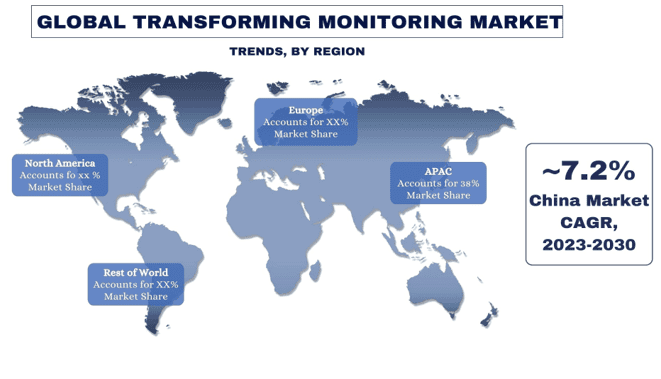
Branchenüberblick zur Transformatorüberwachung
Der Markt für die Transformatorüberwachung ist wettbewerbsintensiv und fragmentiert, mit der Präsenz mehrerer globaler und internationaler Marktteilnehmer. Die wichtigsten Akteure verfolgen verschiedene Wachstumsstrategien, um ihre Marktpräsenz zu verbessern, wie z. B. Partnerschaften, Vereinbarungen, Kooperationen, neue Produkteinführungen, geografische Expansionen sowie Fusionen und Übernahmen. Zu den wichtigsten Akteuren auf dem Markt gehören Siemens, Schneider Electric, Mitsubishi Electric Corporation, General Electric Company, ABB, Honeywell International, Inc., Eaton, Advanced Power Technologies, KJ Dynatech Inc. und S&C Electric Company.
Marktnachrichten zur Transformatorüberwachung
- Im Februar 2024 brachte Schneider Electric EcoStruxure™ Transformer Expert in Großbritannien und Irland auf den Markt, um die Lebensdauer von Öltransformatoren zu verlängern und Ausfallzeiten zu reduzieren
- Im August 2023 brachte Siemens eine neue Generation von Leitungsüberwachungsrelais auf den Markt: „The SIRIUS 3UG5“ kombiniert bewährte Technologie mit neuen Funktionen und Anwendungen. Die Relais sind der einfachste Weg, um die normgerechte Netzstabilität und -qualität zu überwachen und so den ordnungsgemäßen Systembetrieb und eine lange Lebensdauer von Komponenten wie Motoren oder Kompressoren zu gewährleisten.
- Im August 2021 entwickelte Hitachi ABB Power Grids eine neue Reihe von TXpert™ Remote Services für Transformatorflotten. Das Angebot umfasst Fernüberwachung, Beratung, Fehlersuche und Anleitung mithilfe von Augmented Reality.
Berichterstattung über den Markt für die Transformatorüberwachung
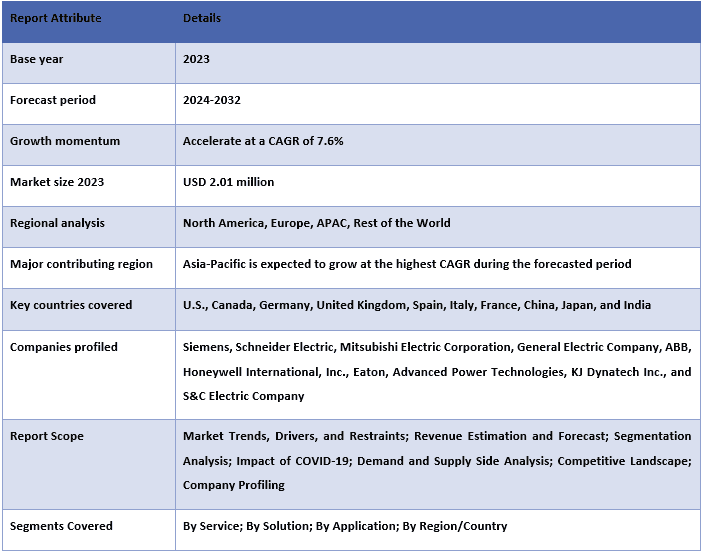
Gründe für den Kauf dieses Berichts:
- Die Studie umfasst eine Analyse der Marktgröße und Prognose, die von authentifizierten wichtigen Branchenexperten validiert wurde.
- Der Bericht bietet einen schnellen Überblick über die Gesamtleistung der Branche auf einen Blick.
- Der Bericht enthält eine eingehende Analyse der wichtigsten Branchenkollegen mit einem primären Fokus auf wichtige Finanzdaten, Produktportfolios, Expansionsstrategien und aktuelle Entwicklungen.
- Detaillierte Untersuchung der Treiber, Beschränkungen, wichtigsten Trends und Chancen, die in der Branche vorherrschen.
- Die Studie deckt den Markt umfassend über verschiedene Segmente hinweg ab.
- Tiefgreifende regionale Analyse der Branche.
Anpassungsoptionen:
Der globale Markt für die Transformatorüberwachung kann je nach Anforderung oder einem anderen Marktsegment weiter angepasst werden. Darüber hinaus versteht UMI, dass Sie möglicherweise Ihre eigenen geschäftlichen Anforderungen haben. Zögern Sie daher nicht, sich mit uns in Verbindung zu setzen, um einen Bericht zu erhalten, der Ihren Anforderungen vollständig entspricht.
Inhaltsverzeichnis
ForschungsMethodik für die Marktanalyse zur Transformatorüberwachung (2024-2032)
Die Analyse des historischen Marktes, die Schätzung des aktuellen Marktes und die Prognose des zukünftigen Marktes des globalen Marktes für Transformatorüberwachung waren die drei Hauptschritte, die unternommen wurden, um die Einführung der Transformatorüberwachung in wichtigen Regionen weltweit zu erstellen und zu analysieren. Umfassende Sekundärforschung wurde durchgeführt, um die historischen Marktzahlen zu sammeln und die aktuelle Marktgröße zu schätzen. Zweitens wurden zahlreiche Erkenntnisse und Annahmen berücksichtigt, um diese Einsichten zu validieren. Darüber hinaus wurden umfassende Primärinterviews mit Branchenexperten entlang der Wertschöpfungskette des globalen Marktes für Transformatorüberwachung geführt. Nach der Annahme und Validierung der Marktzahlen durch Primärinterviews haben wir einen Top-Down/Bottom-Up-Ansatz verwendet, um die gesamte Marktgröße zu prognostizieren. Danach wurden Methoden zur Marktaufgliederung und Datentriangulation angewendet, um die Marktgröße von Segmenten und Untersegmenten der betreffenden Branche zu schätzen und zu analysieren. Die detaillierte Methodik wird im Folgenden erläutert:
Analyse der historischen Marktgröße
Schritt 1: Eingehende Studie von Sekundärquellen:
Es wurde eine detaillierte Sekundärstudie durchgeführt, um die historische Marktgröße des Marktes für Transformatorüberwachung aus unternehmensinternen Quellen wie Jahresberichten und Finanzberichten, Performance-Präsentationen, Pressemitteilungen usw. und externen Quellen wie Fachzeitschriften, Nachrichten und Artikeln, Regierungsveröffentlichungen, Wettbewerberveröffentlichungen, Branchenberichten, Datenbanken von Drittanbietern und anderen glaubwürdigen Veröffentlichungen zu erhalten.
Schritt 2: Marktsegmentierung:
Nachdem wir die historische Marktgröße des Marktes für Transformatorüberwachung erhalten hatten, führten wir eine detaillierte Sekundäranalyse durch, um historische Markteinblicke und Anteile für verschiedene Segmente und Untersegmente für wichtige Regionen zu sammeln. Wichtige Segmente, die in dem Bericht enthalten sind, sind Service, Typ und Anwendung. Weiterhin wurden Analysen auf Länderebene durchgeführt, um die allgemeine Akzeptanz von Testmodellen in dieser Region zu bewerten.
Schritt 3: Faktorenanalyse:
Nachdem wir die historische Marktgröße verschiedener Segmente und Untersegmente erfasst hatten, führten wir eine detaillierte Faktorenanalyse durch, um die aktuelle Marktgröße des Marktes für Transformatorüberwachung zu schätzen. Darüber hinaus führten wir eine Faktorenanalyse unter Verwendung abhängiger und unabhängiger Variablen wie Service, Typ und Anwendung des Marktes für Transformatorüberwachung durch. Es wurde eine gründliche Analyse für Nachfrage- und Angebotsseitenszenarien unter Berücksichtigung von Top-Partnerschaften, Fusionen und Übernahmen, Geschäftsausweitungen und Produkteinführungen im Bereich des Marktes für Transformatorüberwachung weltweit durchgeführt.
Schätzung und Prognose der aktuellen Marktgröße
Aktuelle Marktgröße: Basierend auf den umsetzbaren Erkenntnissen aus den obigen 3 Schritten ermittelten wir die aktuelle Marktgröße, die wichtigsten Akteure auf dem globalen Markt für Transformatorüberwachung und die Marktanteile der Segmente. Alle erforderlichen prozentualen Anteile und Marktaufschlüsselungen wurden unter Verwendung des oben genannten Sekundäransatzes ermittelt und durch Primärinterviews verifiziert.
Schätzung & Prognose: Für die Marktschätzung und -prognose wurden verschiedenen Faktoren, darunter Triebkräfte & Trends, Beschränkungen und Chancen für die Stakeholder, Gewichte zugewiesen. Nach der Analyse dieser Faktoren wurden relevante Prognosetechniken, d. h. der Top-Down/Bottom-Up-Ansatz, angewendet, um die Marktprognose für 2032 für verschiedene Segmente und Untersegmente in den wichtigsten Märkten weltweit zu erstellen. Die Forschungsmethodik, die zur Schätzung der Marktgröße angewendet wird, umfasst:
- Die Marktgröße der Branche in Bezug auf den Umsatz (USD) und die Akzeptanzrate des Marktes für Transformatorüberwachung in den wichtigsten Märkten im In- und Ausland
- Alle prozentualen Anteile, Aufteilungen und Aufschlüsselungen der Marktsegmente und Untersegmente
- Wichtige Akteure auf dem globalen Markt für Transformatorüberwachung in Bezug auf die angebotenen Produkte. Auch die Wachstumsstrategien, die diese Akteure anwenden, um in dem schnell wachsenden Markt zu konkurrieren
Validierung von Marktgröße und -anteil
Primärforschung: Es wurden ausführliche Interviews mit den wichtigsten Meinungsbildnern (Key Opinion Leaders, KOLs) geführt, darunter Führungskräfte der obersten Ebene (CXO/VPs, Vertriebsleiter, Marketingleiter, Betriebsleiter, Regionalleiter, Länderleiter usw.) in wichtigen Regionen. Die Ergebnisse der Primärforschung wurden dann zusammengefasst und eine statistische Analyse durchgeführt, um die aufgestellte Hypothese zu beweisen. Die Ergebnisse der Primärforschung wurden mit den Ergebnissen der Sekundärforschung zusammengeführt, wodurch Informationen in umsetzbare Erkenntnisse umgewandelt wurden.
Aufteilung der primären Teilnehmer in verschiedene Regionen
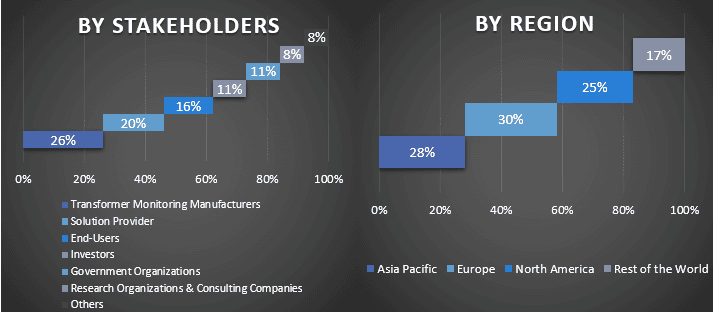
Markt Engineering
Die Datentriangulationstechnik wurde angewendet, um die gesamte Marktschätzung abzuschließen und präzise statistische Zahlen für jedes Segment und Untersegment des globalen Marktes für Transformatorüberwachung zu erhalten. Die Daten wurden in mehrere Segmente und Untersegmente aufgeteilt, nachdem verschiedene Parameter und Trends in den Bereichen Service, Typ und Anwendung im globalen Markt für Transformatorüberwachung untersucht wurden.
Das Hauptziel der globalen Marktstudie zur Transformatorüberwachung
Die aktuellen und zukünftigen Markttrends des globalen Marktes für Transformatorüberwachung wurden in der Studie genau bestimmt. Investoren können strategische Einblicke gewinnen, um ihre Entscheidungen für Investitionen auf der Grundlage der in der Studie durchgeführten qualitativen und quantitativen Analyse zu treffen. Aktuelle und zukünftige Markttrends bestimmten die Gesamtattraktivität des Marktes auf regionaler Ebene und boten den Industrieteilnehmern eine Plattform, um den unerschlossenen Markt zu erschließen und von einem First-Mover-Vorteil zu profitieren. Weitere quantitative Ziele der Studien sind:
- Analyse der aktuellen und prognostizierten Marktgröße des Marktes für Transformatorüberwachung in Bezug auf den Wert (USD). Analysieren Sie auch die aktuelle und prognostizierte Marktgröße verschiedener Segmente und Untersegmente
- Die Segmente in der Studie umfassen die Bereiche Service, Typ und Anwendung
- Definition und Analyse des regulatorischen Rahmens für die Transformatorüberwachungsbranche
- Analyse der Wertschöpfungskette unter Einbeziehung verschiedener Vermittler sowie Analyse des Kunden- und Wettbewerberverhaltens der Branche
- Analyse der aktuellen und prognostizierten Marktgröße des Marktes für Transformatorüberwachung für die wichtigsten Regionen
- Zu den wichtigsten Ländern der in dem Bericht untersuchten Regionen gehören der asiatisch-pazifische Raum, Europa, Nordamerika und der Rest der Welt
- Unternehmensprofile des Marktes für Transformatorüberwachung und die Wachstumsstrategien, die von den Marktteilnehmern angewendet werden, um sich in dem schnell wachsenden Markt zu behaupten
- Tiefgehende regionale Analyse der Branche
Häufig gestellte Fragen FAQs
F1: Wie groß ist der aktuelle Markt und welches Wachstumspotenzial hat der Markt für Transformer Monitoring?
F2: Was sind die treibenden Faktoren für das Wachstum des Marktes für Transformatorenüberwachung?
F3: Welches Segment hat den größten Anteil am Markt für Transformer Monitoring nach Serviceleistung?
F4: Welche aufkommenden Technologien und Trends gibt es auf dem Markt für Transformatorenüberwachung?
F5: Welche Region wird den Markt für Transformatorenüberwachung dominieren?
Verwandt Berichte
Kunden, die diesen Artikel gekauft haben, kauften auch






